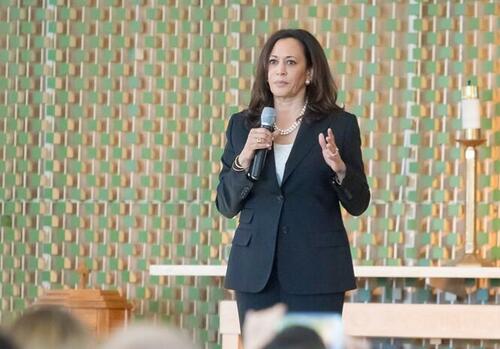Artifice Of The Deal: Harris’ ‘Politics Of Joy’ Ends In Tears
Authored by Alex Rosado via RealClearPolitics,
For months, legacy media and Kamala Harris’ presidential campaign fawned over the positivity and change the vice president could offer the presidency. Given her decisive loss to Donald Trump this month, it seems voters were not persuaded by the “politics of joy”– and her base is melting down over it.
This cycle’s polls testified to voters’ distaste for the incumbent Biden administration. Citizens were, and still are, concerned with the national economy and crime rates, which have worsened their quality of life.
The Harris campaign tried to distract Americans from that criticism by projecting an upbeat image. Yet, even an army of actors, musicians, and public figures endorsing Harris and trashing then-candidate Donald Trump could not make up for her lack of tangible solutions. Her rallies created an atmosphere of communal excitement for those in attendance, but her policies lacked substance and broad appeal. It took the campaign several weeks to release a detailed policy platform when she first entered the race – most were ripped from Biden’s unpopular tenure that voters disliked, and she would admit this herself.
Most of America saw nothing gleeful about being stuck with the same ineffective policies for another four years, but those supporters who liked her “feel-good” environments were bound emotionally to her campaign.
Harris’ emotional appeal had a twofold effect: to ostracize dissenters who demanded more policies from their candidate, and to insulate her supporters until they believed that they were in the majority – even as their numbers shrank. This same energy transformed political gatherings into pseudo-festivals more than serious discussions. And, when feelings dominate, the blowback can be more severe. That’s why many religious and pro-life voters were stunned when Harris told two Christians they were “at the wrong rally” in late October. Harris couldn’t emphasize unity at her rallies if she alienated certain groups that didn’t align with her beliefs, and Christians remembered this by voting mostly for Trump in 2024.
The divide extended behind the scenes, too. Since Biden was ousted from the presidential race in August, there has been a reported feud between his and Harris’ camps. Harris staffers say the White House didn’t sufficiently coordinate Biden’s messaging and schedule to align with the vice president’s campaign interests. Ex-Biden staffers who joined Harris’s campaign have also been branded “disloyal.” The rift was reaffirmed when Harris sidelined Biden, refusing to campaign with him in the campaign’s final stretch.
The supposed “joy” of Harris’ campaign merely masked the party’s factionalism. Observers and Republicans pounced on this, calling Harris’ nomination a hoax, and Americans started questioning her rise to the top of the ticket. Authentic or not, Harris struggled with justifying why she was the nominee and used happiness to conceal genuine ideological differences within her party.
The split between Biden and Harris was so apparent that publications wondered if Biden was trying to sabotage Harris’ campaign. The Democrats’ divided house could not stand, and skeptical voters were concerned about the dysfunction. They were proven correct when, in the election aftermath, Harris’ allies and the media blamed Biden for her loss.
Even as the Obamas, Clintons, Democratic vice-presidential nominee Tim Walz, and Oprah Winfrey stressed that Americans must choose “joy,” their rhetoric told a different story.
The Harris campaign painted Trump as a “fascist” and a “dictator,” with Biden jumping in and calling Trump supporters “garbage.” They spent months fearmongering over Project 2025, a political initiative by The Heritage Foundation that Trump repeatedly said he does not endorse. Democrats went as far as to tie Trump to Adolf Hitler, with Walz comparing a Trump rally to a Nazi gathering.
Their hypocritical, far-from-cheerful rhetoric was a Hail Mary attempt to gain ground in the election. Polls had Kamala trailing Trump nationwide and in swing states because she could not define herself.
The politics of “joy” could not convince voters that she was in touch with their needs. To close the gap, she instead chose the politics of panic. Neither could deliver her the presidency.
Even if Trump’s rhetoric made some Democrats feel “concerned, exhausted, angry, insulted, and confused” in his first term, most of the country wanted his aura for a second term. It’s why disaffected Democrats like Robert F. Kennedy Jr., Elon Musk, and former Congresswoman Tulsi Gabbard were vital in building coalitions and a diverse policy platform for Trump. Trump could ride around in a garbage truck while still campaigning on no taxes for social security, energy abundance, and ending foreign wars. He balanced proposals with optics, something the Harris campaign couldn’t figure out.
At its core, politics is about governance and resource allocation; everything else is noise. Harris’ campaign sought to replace policy with good vibes. When that failed, only anger remained. Disillusioned with the results, the Harris camp is now guilting everyone – including a baby hippo overseas – for their mistakes.
The Harris campaign’s joy, rage, and detachment from voters is no mystery and is why she couldn’t master the art of the deal.
Alex Rosado is a Research Fellow for Horizon Info Consult, and a Contributor for Young Voices. Follow him on Twitter/X at @Alexprosado.
Tyler Durden
Mon, 11/18/2024 – 18:25


